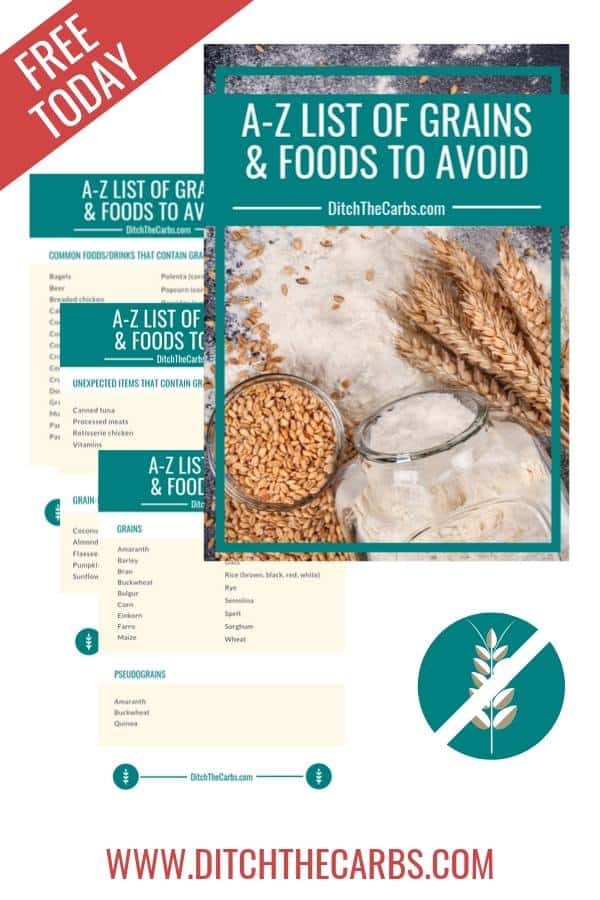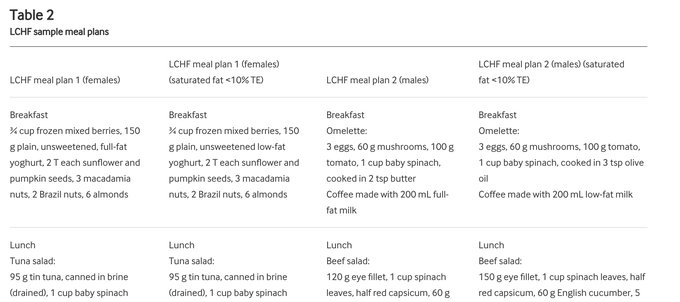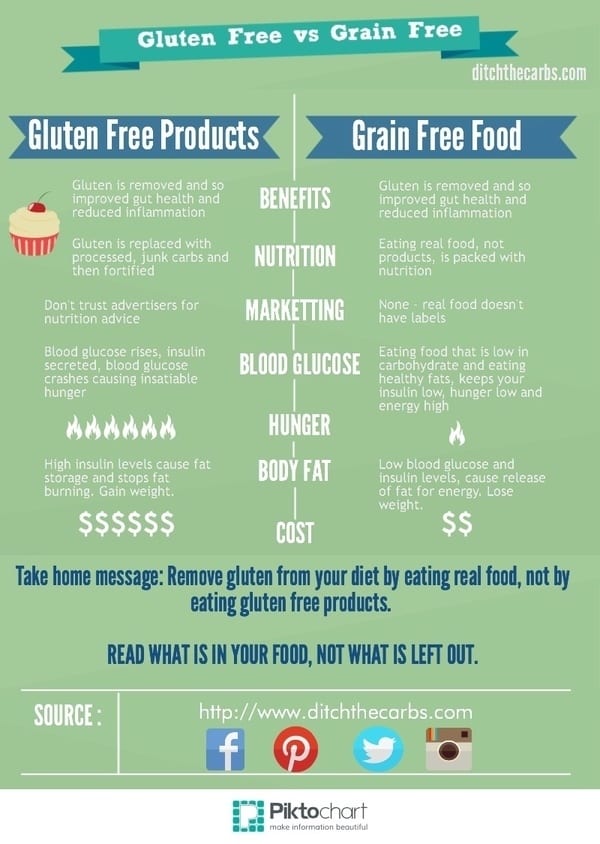Have you ever asked yourself “what is grain-free diet” or “what is a gluten-free diet”? You’re not alone. In fact, many people in the world don’t really know the difference between being grain-free and gluten-free either.
Is it necessary to live grain-free? What’s the difference to gluten-free? Is it a fad diet? Is it for everyone? What about healthy whole grains? And what’s so wrong with gluten anyway, surely we’ve been eating bread for thousands of years right?

TO GET YOUR FREE PRINTABLE A-Z LIST OF GRAINS & FOODS TO AVOID – CLICK HERE.
What Is An Allergy?

A true allergy is where your body protects itself from an allergen such as peanuts or shellfish. Reactions can be mild or cause an anaphylactic shock that requires emergency treatment with adrenaline, otherwise, it can be fatal.
An autoimmune disease is where the body protects itself from an allergen by attacking its own healthy tissues. Symptoms can be take days, months or years to show such as arthritis, thyroid.
Are you ready to lose weight and heal your body for life (without dieting, drugs, or making yourself miserable)?

Our free on-demand video training will walk you through how to make this THE year you set health goals…and keep them.
An intolerance is where someone cannot tolerate a type of food such as lactose. The immune system is not involved, but symptoms are just as severe.
1: What is a grain?

If you’ve ever asked someone who is low-carb, keto or Paleo about what they can and can’t eat, you may hear them mention that they are grain-free.
Some people think that grains are only found in items like bread or other flour-based foods. But grains can actually be found in so many everyday foods that you wouldn’t suspect (see below).
Any food that is made using rice, oats, wheat, cornmeal, etc. are actually made from grains. So while this does include bread, it also includes food items such as :
- bread – wholegrain, white, brown, organic
- pasta – lasagne, macaroni and also noodles
- sweet treats – cakes, cookies, bagels, muffins, cupcakes,
- granola – cereals, muesli, granola bars, porridge, oats
- junk food – pizza, tortillas, tacos, crumbed fried chicken, popcorn
- drinks – beer, oat milk,
Those who eat low-carb or keto tend to avoid grains the majority of the time. In addition to being sugar-free, it’s one of the biggest components to having stable blood sugars, controlling your appetite, losing weight and keeping the weight off.
TO GET YOUR FREE PRINTABLE A-Z LIST OF GRAINS & FOODS TO AVOID – CLICK HERE.
2: What is gluten-free?

Gluten is a protein found in grains such as wheat, rye, and barley. A gluten-free diet is a diet that excludes gluten completely.
Many people have an allergy or intolerance to gluten. Coeliac disease is an autoimmune disease triggered by gluten.
Gluten intolerances used to be relatively uncommon but are now becoming more commonplace. More and more people around the world are starting to eat and live a gluten-free lifestyle whether they have been diagnosed with such a condition or not. gluten-free
Many people discover when they live gluten-free it frees them from symptoms such as bloating, gas, stomach pains, diarrhoea, constipation and other symptoms similar to irritable bowel syndrome. But are gluten-free products as healthy as the manufacturers claim they are? The answer may surprise you.
If you live a gluten-free diet, can you eat grains?
Anyone living a gluten-free diet cannot consume gluten-containing grains. There are, however, some grains that are gluten-free such as rice, corn and oats.
Are grain-free foods, gluten-free too?
Yes.
Gluten is only found in certain grains so if you live grain-free, you are gluten-free, by default.
This can actually be helpful in keeping it all straight and less confusing. If you know that food is grain-free, then you can also rest easy knowing that it’s gluten-free as well.
3: What are Pseudocereals?

These may appear to be a grain but are actually seeds. They are 100% gluten-free. And they are important to be aware of when you’re cutting grains from your diet. (now you know when you’re reading labels what these ingredients actually are!)
- Amaranth
- Buckwheat
- Quinoa
- Millet
Depending on your carbohydrate tolerance, you may choose to include some pseudocereals in your diet and your macronutrient goals/limits. It’s ultimately up to you. However, generally, those who are on the low-carb, ketogenic, Paleo or Primal diet, however, don’t consume any of these seeds.
4: What is a grain-free diet?

As you now know, grains can spike your blood sugars tremendously (and so raise our insulin requirements), grains may contain gluten (which may cause gut and intestinal issues) and grains are full of rapidly absorbed carbohydrates with minimal nutrition.
People who follow a low-carb, ketogenic, Paleo or Primal diet, are all grain-free. And because they are grain-free, it automatically means they are gluten-free too.
They avoid all products that contain grains. By removing grains, bread, pasta and rice from their diet, they introduce nutrient-dense foods such as quality proteins, meat, fish, non-starchy vegetables, low-sugar berries, nuts and seeds.
There is no nutrient in grains that cannot be found in other high-quality food sources.
5: Benefits of a grain-free diet

There are numerous health benefits of living grain-free, including:
- Reduced carbohydrate – a grain-free diet helps achieve stable blood sugars and reduced insulin requirements
- Reduced gastrointestinal symptoms – a grain-free diet (which is automatically gluten-free) is a nutritious way for those who are intolerant to gluten (for example Coeliacs). But whether you are a Coeliac or not, removing gluten from your diet may help with reduced symptoms such as bloating, diarrhoea, excess gas, headaches, itchy skin, eczema and stomach pain.
- Helps weight loss – not only does a grain-free diet reduce your carbohydrates, and give stable blood sugars, it helps reduce the intake of processed junk food such as pasta, bread, cakes and cookies. Living grain-free helps with appetite control and weight loss, in addition to all the amazing health benefits that low-carb and keto diet brings.
- Reduced inflammation – by eliminating grains, sugar, refined carbohydrates and seed oils, we are setting the foundation for reducing inflammation in our body and our risk of all the major diseases associated with old age. Alzheimer’s, T2 diabetes, arthritis, cancer, heart disease, hypertension, stroke.
- Increased nutrition – when we remove grains from our diet, we no longer have meals bulked out with cheap pasta, bread or rice. Instead, we enjoy a variety of quality proteins, non-starchy vegetables, full-fat dairy, nuts, seeds and low-sugar berries. There is absolutely no deprivation in living a grain-free lifestyle.
6: What to avoid in grain-free diets or gluten-free diets

Grains can be found in bread, pasta, rice, cookies, cakes, granola bars, granola and cereal. Grains can also be found in the most unlikely places such as canned tuna, rotisserie chicken and sausages.
Old food pyramids state that we should be eating a whopping 6-11 servings of grains per day, new food plates show more than 1/4 of your diet should include grains, and they no longer even mention meat! They quietly removed the word meat and use “protein” in its place.
But are these nutritious ways to eat? With all those grains spiking your blood sugars, we don’t think so.
When you live low-carb or keto, we remove grains entirely from our diets. We gain amazing blood sugar control, we eat a variety of meat, dairy, seeds, nuts, low-sugar fruits and leafy vegetables in abundance.
And do we miss out on any nutrition? No. The small loss of fibre and vitamins from fortified bread is easily improved by living the low-carb lifestyle. In fact, we exceeded our daily requirements.

Source: BMJ – Assessing The Nutrient Intake Of A Low-Carb High Fat Diet
Where can grains be hidden that you might not know?
Surprisingly, grains can be found in the most unexpected place. This is why when you’re eating low carb or Keto, you have to be really aware of items that can contain grains. If in doubt, always read the nutrition label.
Some of these food items that might contain grain include:
- Chicken, beef, or vegetable stock that you’ll find at the store
- Beer
- Soy Sauce
- Beer
- Canned tuna in sauce
- Sausages
TO GET YOUR FREE PRINTABLE A-Z LIST OF GRAINS & FOODS TO AVOID – CLICK HERE.
7: Foods to enjoy in a grain-free diet

Cutting out grain and gluten might feel like you’re restricting yourself, but as you can see from the BMJ study above, there is absolutely no deprivation or reduced nutrition when living LCHF. In fact, it is more nutritious than the SAD (Standard American Diet).
Just look at everything you may enjoy instead:
- Quality meat
- Fish
- Eggs
- Seafood
- Full-fat dairy
- Non-starchy vegetables
- Low-sugar nutrient-dense berries
- Nuts
- Seeds
- Extra virgin olive oil
8: What grain-free flours can you use?

If you’re wanting to create a loaf of grain-free baked goods such as cakes, cookies and bread, these grain-free flour alternatives can help you bake and enjoy your treats:
- Coconut flour
- Almond flour/meal
- Sunflower seed flour
- Pumpkin seed flour
These are just a few of the grain-free flour alternatives that you can easily incorporate into your kitchen. While there might be a bit of a learning curve, in the beginning, to use them in baking, with enough practice you’ll be enjoying your homemade recipes in no time at all.
9: Why avoid gluten-free products?

To read the full article Gluten-Free vs Grain-Free – CLICK HERE.
Gluten-free products and flours are generally based on high carbohydrate alternatives such as rice flour, potato and tapioca starch. Gluten-free products have almost zero nutrition.
Take a look at the nutrition panel, you will see how high the carbohydrate content is and any vitamins or minerals it contains, are usually added because it is fortified. Gluten-free products are incredibly expensive and some may say, akin to junk food.
TO GET YOUR FREE PRINTABLE A-Z LIST OF GRAINS & FOODS TO AVOID – CLICK HERE.
WHAT IS A GRAIN-FREE DIET – REFERENCES:
- Credit: Food Pyramid, choose my plate.
- https://www.ncbi.nlm.nih.gov/pubmed/22493548
- https://www.ncbi.nlm.nih.gov/pmc/articles/PMC5866307/
- https://www.ncbi.nlm.nih.gov/pmc/articles/PMC2780863/
What if you could actually take control of
your health in just 10 days?
It’s not your fault you can’t lose weight as a woman over 40 even though you’ve likely tried literally everything. Your metabolism probably feels broken and your hormones are likely all out of whack.
But you can fix it all with ONE simple change: eliminate sugar. We make it super easy with daily lessons teaching you the science behind what makes us gain weight in our midlife and beyond! Are you ready to get started now?












Technically, grains are also seeds, it’s just that they’re the seeds of grasses while pseudo-cereals are the seeds of plants that are not grasses.
On that basis, millet is actually a grain, or rather a group of grains as there are apparently several species, all of them grasses.
Really enjoyed reading this article, along with the low carb vs high protein for vegetarians. However I am struggling were to start changing my diet. Do you have a food diary example for a veggie going grain free and keeping protein high?
I also don’t eat much dairy products (stick to almound or oat milk/no cheese)
Any help would be much appreciated
Thanks
I’m so glad this has been helpful. I have a vegetarian meal plan in my Vegetarian Cookbook, and if you use my meal planning service, you can select no meat. Alternatively, look at my vegetable recipes and side dishes archive here, and 28 low-carb vegetarian meals,